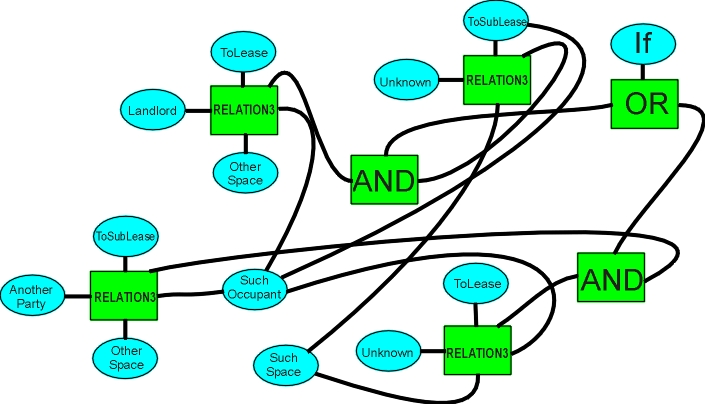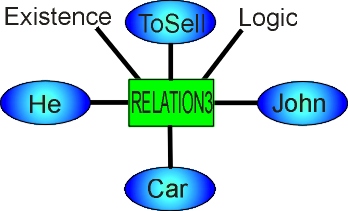
The relation structures mostly follow what an English grammar would say. Sometimes we need to move away from grammar towards structure, it being much simpler to represent complicated statements in structure.
There is
He runs.
He exists.
He runs a business.
He owns a boat.
He called the research a failure.
This is a relation with a subject and two direct objects - that is, there is no need for a preposition to couple the second object.

He sold John a car.
John bought the car from him. "Buy" and "Sell" are relations mapped to each other through a SYNONYMMAP.
He bought John a car.
The verb "buy" is not really ditransitive, and the relation between John and car is not "sell", but "have" - he bought a car (from someone) for John to have. Calling both forms ditransitive is confusing, but maps are used to differentiate the structures and build the auxiliary relations.
He leased John a car.
"Lease" is unusual, because a landlord leases premises to a tenant, and a tenant leases premises from a landlord. Maps are used to untangle which is which, based on whether the subject is more likely to be the lessor or the lessee.
In legal text, the relation is commonly written
The landlord leases to the tenant, and the tenant leases from the landlord, the premises.
illustrating how clumsy language becomes when it attempts to describe structural order directly.
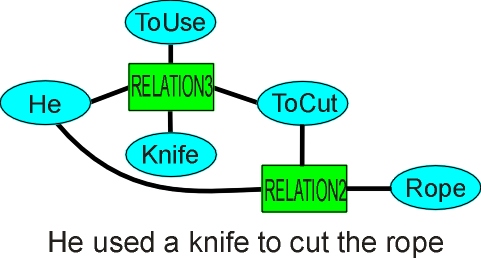
He used a knife to cut the rope.
The structure tightly combines two relations, as shown:
One could argue the point over whether the person cut the rope, or the knife did.
The lessee is obligated to pay the lease charges.
The structures can become increasingly complicated, following a pattern, as
He used the lease to obligate the lessee to pay John the rent.
At some point, the machine following a patterned structure will have a much easier time of it than a human operating on linear text.
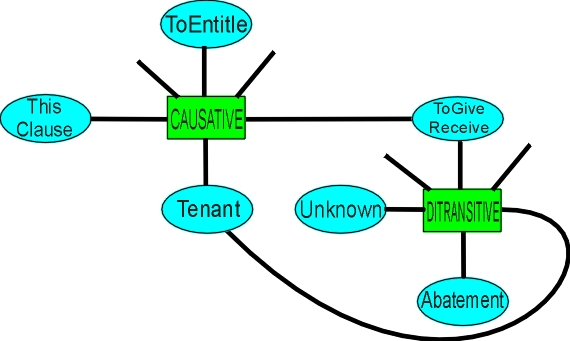
Tenant shall be entitled to receive an abatement
ToEntitle is causative, while ToReceive is one half of ToGiveToReceive. The connections are spun around to suit.
They elected John a Director.
This has an implied ToBe, as
They elected John (to be) a Director.
The Factitive form defaults to Causative when followed by an infinitive, as
They elected Arnold Shwarzenegger Governor of California.
They elected Arnold Shwarzenegger to govern California.
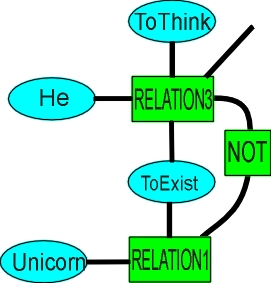
The lessor thought the lessee is obligated to pay the lease charges.
The lessor thought that the lessee is not obligated to pay the lease charges.
The "that" can be implicit or explicit. A small set of verbs indicating cognitive activity - think, feel, agree, realize, consider - can support following clauses. The connection to the clausal relation has to catch both the relation and its logical control. A logical negation can occur on either side of the relation and produce the same meaning:
He thought that unicorns did not exist.
He did not think that unicorns existed.
The logical connection from the clausal relation expresses what exists in a person's head, rather than what is external. Put another way,
| John failed the test. | |
| He thought John failed the test. |
the verb "think" allows a complete universe to exist, by giving to "think" the same control connections a sentence has. The controlled relation can be false, but he still thought it to be true.
Some other verbs also support an existence and logical connection, but only support an "infinitive clause", as
He failed to complete the race.
"failed" here is the equivalent of a logical not.
A set of verbs which connect a noun phrase and an adjectival phrase.
He kept the engine warm by idling it.
A set of verbs that support an object and an infinitive - the object becomes the subject of the infinitive (in some examples, the "to" has fallen into disuse):
He asked John to run the marathon.
He made John wash the dishes.
A set of verbs which have a negative connotation -
He prevented John from finishing the race.
A set of verbs that support an object and a clause - to do with transfer of information to a person:
He told John he was late.
A set of verbs referring to mental states that support a clause as a subject, when used in passive form:
He was annoyed that the train was late.
That the train was late annoyed him.
He was overjoyed that he had won the lottery.
The Tenant is paid to wash the windows.
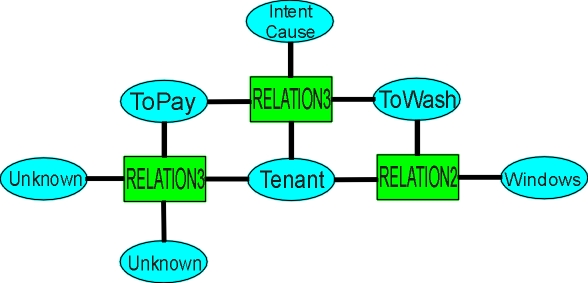
The IntentCause relation is implicit in the sentence structure, explicit in the network structure. This is quite different to
The falling rock caused the window to break.
The relation between payment and washing is circular - the Tenant believes he will be paid, so washes the windows, and is paid. The RELATION3 expresses this circularity directly, with IntentToCause in one direction, Cause in the other.
He wanted a doughnut.
This is a short form of "He wanted something to be true" - the statement makes no assertion as to whether the statement is possible, only its truth is sought. It may fail because it is impossible (structure does not exist) or because it is not valid, but the "wanting" can still be true. The relation connection is unusual, in that a state is looked for, rather than asserted.
Larger Example
